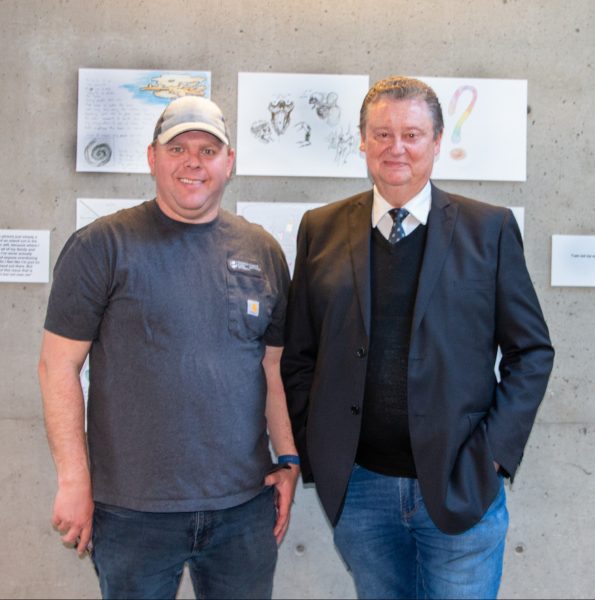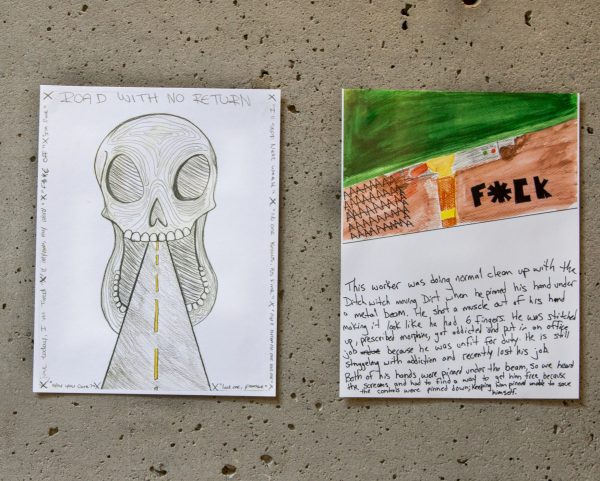Nearly 50 pieces of artwork line the halls of TRU’s School of Trades and Technology building. It may not be what you expect to see there, but that’s the point.

Jason Schapansky and Dr. Will Garrett-Petts
The heart of this art research exhibit is to start conversations, uncover hidden lived experiences and amplify the voices of people in trades affected by BC’s opioid and toxic overdose crisis.
The Impact of the Toxic Drug Overdose Crisis on People in Trades project stems from a multi-community-university collaborative project, three years in-the-making.
Students, faculty and community advisors wanted to better understand the opioid crisis through the lens of trades apprentices and workers. Participants were asked to create personal and unique cultural maps that researchers can use as starting points for semi-structured interviews.
The maps, interview recordings, photographs and transcripts are all exhibited in publications, video productions and community or academic presentations like the one that ran in TRU Trades and Technology building March 12-14. The goal is to increase public awareness and involvement, and the project is being conducted in Kamloops, Comox Valley and Campbell River.
Stunning and disturbing

Lana Fine, master of arts student researcher, holding Naloxone kit
The result is both stunning and disturbing in a way that pulls students, faculty and community members into conversation in the busiest hallway of the trades building, explained Will Garrett-Petts, principal investigator, TRU professor and special advisor on integrated strategic planning.
Lived experiences range from people directly impacted by opioid use disorder to those in an industry teaming with occurrences that are all too often silenced by stigma.
Challenging substance use stigma
“A major part of this conversation is to address stigma around substance use and to challenge previously held misconceptions,” said Lana Fine, a TRU graduate student and research assistant in the Master of Arts Human Rights and Social Justice program. She led Naloxone training that saw as many as 85 participants over three days.
Naloxone is a medication that quickly reverses the effects of opioids such as heroin, methadone, fentanyl and morphine. It acts as an opioid blocker and can reverse fatal overdoses.
“It is no surprise that people use drugs, so we need to find a way to keep people safe that are active in substance use. When people do not feel safe to share with others that they are using, due to the shame and stigma they experience, people use substances alone,” she said.
“You cannot revive yourself and this is how people are dying. Therefore, creating safe spaces for people to talk about substance use is extremely important. Further, knowing how to confidently use Naloxone when responding to an overdose gives people a chance to live another day, and helps to address the senseless loss of lives resulting from the toxic drug overdose crisis.

Cultural maps
“The exhibition aims to engage those working in the trades, the staff and students of TRU, and the community, in meaningful dialogue about substance use,” said Fine.
The BC Centre for Disease Control started the Take Home Naloxone program in 2012 to provide life-saving training and kits to reduce opioid-related deaths.
“Anyone can learn to use Naloxone and successfully reverse an overdose. We want to teach them to do so,” said Fine, who has been working in Victoria for the past eight years on the front lines of the overdose crisis for a harm-reduction organization, and has lost many people, including her younger sibling, to overdose. It’s her driving force.
Experiences inform research, research informs education
Jason Schapansky, TRU electrical instructor involved in the project, is advocating for more education about opioid use within trades.
“This project is a research project that came about with stats that came out saying there is a problem or a crisis, let’s call it, on drug overdose and opioids, specifically to men in trades. That is when we started it. It’s spiralled from there. We’ve learned through the research project that it is more than men in trades. There is a trades-related issue, absolutely, and we’re researching it and trying to do something about it,” he said in a media interview.
Schapansky said it’s not just men affected — women are as well — and everyone he has spoken with has a story involving the opioid crisis.
The Canadian Institute for Health Information reported in 2018 that smaller cities are hit the hardest by the drug crisis. Communities like Kamloops bear a disproportionate weight and have hospitalization rates for opioid-related issues at 2.5 times higher than rates in Canada’s largest cities. As the opioid crisis continues, the voices of people with lived experiences are more important than ever.

Cultural maps
“We do safety training regularly. Everyone knows to use three points of contact when you use a ladder and to cut away from yourself with a knife. There is nothing in the curriculum about drug awareness or overdose awareness, so our goal here is to make that happen. We hope the micro credential training course will be as required as Food Safe when you go and work at a restaurant. The talk is not there right now but we hope it will be every time you step into a classroom or worksite and maybe we can minimize what’s happening right now,” Schapansky told CBC.
“The longer-term goal is a commitment from the university to develop a micro-credential related to workplace safety but looking at issues of opioid addiction, the drug overdose crisis and the use of substances generally in the workplace. But to get there, we want to start with a relatively informal conversation starter, and that’s what the exhibition does for us,” said Garrett-Petts in a media interview. “It’s a way of engaging not just the students but the faculty and the general public because I think it’s something that affects all of us.”
The research project is funded by the Vancouver Foundation and the Social Sciences and Humanities Research Council, and is a key project supported by the City of Kamloops through the university’s Researcher-in-Residence initiative.

